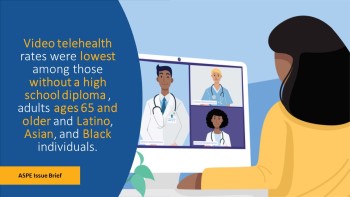Listed below by date of publication are recent data products and research reports on telehealth utilization and policies before, during and after the COVID-19 pandemic.
Impact of COVID-19 public health emergency on federal telehealth policies
ASPE has conducted research on telehealth utilization during the COVID-19 public health emergency (PHE) using national survey data, Medicare claims, and examined changes in state Medicaid telehealth policies. Prior to the PHE, ASPE’s telehealth research also examined various telehealth approaches across settings.
The COVID-19 PHE led to temporary flexibilities by federal and state governments on the use of telehealth to support broad access to care during this period. Some of these flexibilities were subsequently made permanent.
Policy changes during the PHE including temporary waivers of federal telehealth policies for Medicare and Medicaid are summarized on the Telehealth.HHS.gov website, maintained by the Health Resources and Services Administration
Partner Resources
The Telehealth.HHS.gov website provides information for health care providers and patients about the latest federal efforts to support and promote virtual health care, known as telehealth. It was built by the Health Resources and Services Administration (HRSA), an agency of the U.S. Department of Health and Human Services (HHS).
Telehealth Data Products
Medicare Telehealth Trends Dashboard, 2019-2021
June 30, 2023

This dashboard uses 2019-2021 Medicare FFS claims data, aggregated by beneficiary characteristics, visit specialty and state to allow users to explore different trends in telehealth use during the COVID-19 pandemic compared with 2019. This tool is intended to provide broad trends in Medicare telehealth use and change over time. Users to manipulate aggregated Medicare FFS claims data to address their own policy and research questions of interest.
Telehealth Reports
Trends and Disparities in Pandemic Telehealth Use among People with Disabilities

This Issue Brief examines telehealth use among people with disabilities and Medicare beneficiaries, particularly focusing on audio-only telehealth during the second and third years of the COVID-19 pandemic. Using data from various surveys, the study found that telehealth usage increased during the pandemic, with higher adoption among people with disabilities compared to those without disabilities. Despite this increase, overall care rates declined, with a more significant decline among people with disabilities. Audio-only telehealth was prevalent among people with disabilities and older adults, indicating its importance in maintaining access to care. The study also highlighted that people with mobility disabilities had the highest telehealth usage, while those with hearing disabilities had the lowest, suggesting the need for tailored telehealth policies and platforms to address different communication needs.
State Medicaid Telehealth Coverage Policy Decisions Since the COVID-19 Public Health Emergency
July 12, 2023

ASPE contracted with RAND Health Care to catalogue and assess state changes to Medicaid telehealth policies during the COVID-19 PHE through May 2022 and identify the driving circumstances, motivations, and evidence supporting telehealth policy decisions during the COVID-19 Public Health Emergency (PHE). The purpose of this study was to review changes to state Medicaid telehealth policies and/or new policies enacted during the COVID-19 PHE, examining policies that were rolled back, as well as those made permanent in part or in whole.
Read the State Medicaid Telehealth Coverage Policy Decisions Issue Brief
Updated Medicare FFS Telehealth Trends 2019-2021 by Beneficiary Characteristics, Visit Specialty, and State
July 20, 2023

Building on prior ASPE reports, this research report provides updates trends in Medicare fee-for-service Part B visits and use of telehealth from 2019 to 2021 during the COVID-19 public health emergency (PHE) by beneficiary characteristics, visit specialty, and state. The report is accompanied by an interactive Medicare Telehealth Trends Dashboard.
Read the Medicare Telehealth Trends Research Report
Access the Interactive Medicare Telehealth Dashboard
Updated National Survey Trends in Telehealth Utilization and Modality (2021-2022)
April 20, 2023

Telehealth utilization has changed over time since the steep increase from the early stages of the COVID-19 pandemic. This report updates prior findings on national trends of telehealth use through an analysis using the Census Bureau’s Household Pulse Survey data from April 2021 through August 2022.
Read the National Survey Trends in Telehealth Issue Brief
State Medicaid Telehealth Policies Before and During the COVID-19 Public Health Emergency: 2022 Update
November 22, 2022

This issue brief provides updates on state Medicaid policies regarding delivery of telehealth services by provider types and modalities, as of January 2022. The COVID-19 pandemic substantially accelerated interest in and utilization of telehealth across all payers including Medicaid.
Read the State Medicaid Telehealth Policies Issue Brief

Telehealth services expanded rapidly during the COVID-19 pandemic. Using data from the Census Bureau’s Household Pulse Survey (HPS) in 2021, this Issue Brief analyzes national trends in telehealth utilization across all payers and examines how use of video-enabled vs. audio-only telehealth services differ across patient populations. The study finds notable disparities by race, ethnicity, income, age, and insurance status in access to video-enabled telehealth.
Read the 2021 National Survey Trends in Telehealth Issue Brief

This research report examines changes in Medicare fee-for-service Part B visits and use of telehealth in 2020 during the COVID-19 public health emergency (PHE) by beneficiary characteristics, provider specialty, and location. The analysis found that Medicare in-person visits dropped while telehealth visits increased significantly at the start of the pandemic.
